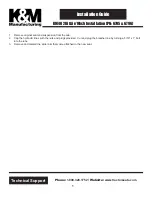
BIKERACE: Service & Maintenance Manual - rev. 1.1
Page 3.3
(4)
POWER SUPPLY
Receives the mains voltage at its input and outputs the DC voltages (+5 Vdc, +12 Vdc and
−
12 Vdc) which supply the display and the alternator interface board.
(5)
ALTERNATOR INTERFACE BOARD
Receives from the display a square wave signal (PWM) whose frequency is proportional to
the difficulty level setting, and converts it into an analogue excitation signal for the alternator.
Receives the RPM signal from the alternator, which it filters and sends to the display for
calculating the speed of exercise (RPM).
(6)
ALTERNATOR
Is put into rotation by the user, and generates a resistance to the movement proportional to the
excitation voltage received from the alternator interface board. It also generates the RPM
signal (6 pulses per revolution) necessary for counting the number of revolutions and hence
measuring the speed. Its rotation produces energy which is dissipated by the power resistor.
Starting from SN 3175, the machines are equipped with a new alternator model
which makes it possible to obtain a lower minimum resistance value. Because the 2
alternators are of the same make (EFEL) and externally identical, the new model is
distinguished by a red mark affixed to the side opposite the flywheel.
Starting from the model manufactured by MAGNETI MARELLI, the excitation
circuit is equipped with a series-connected thermal cutout, which is normally
closed and opens when the temperature exceeds an established threshold.
(7)
POWER RESISTOR
Has the function of dissipating the energy produced by the alternator.
Содержание Bikerace
Страница 1: ...SERVICE MAINTENANCE MANUAL REV 1 1 ...
Страница 2: ......
Страница 4: ......
Страница 14: ...BIKERACE Service Maintenance Manual rev 1 1 Page 2 6 Page intentionally left blank ...
Страница 70: ...BIKERACE Service Maintenance Manual rev 1 1 Page 9 2 Page intentionally left blank ...
Страница 83: ......
















































